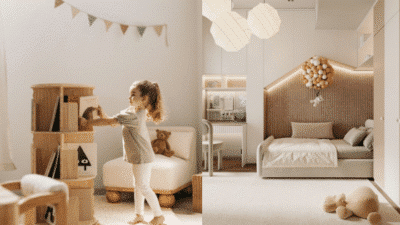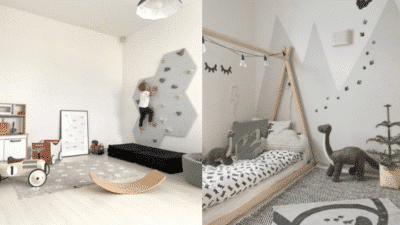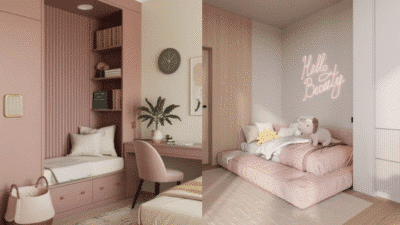Transforming your living space into an urban jungle brings the vitality of nature indoors, creating a harmonious balance between urban living and natural serenity. This design style has surged in popularity, with TikTok views exceeding 600 million and Google searches increasing by 398% compared to last year. Urban jungle interior design combines an abundance of greenery with simple color schemes and natural materials to create spaces that reduce stress and enhance visual appeal.
The beauty of urban jungle design lies in its accessibility—you don’t need a green thumb to embrace this style. By strategically incorporating houseplants alongside elements like white or beige walls, natural textures, and earthy tones such as terracotta, you can create a space that feels both refreshing and sophisticated. The contrast between lush plants and minimalist backdrops allows your greenery to become the focal point, even in smaller spaces.
Key Takeaways
- Urban jungle design blends abundant greenery with neutral colors to create stress-reducing, visually appealing spaces.
- You can achieve this style by combining statement plants with natural materials and textures that complement rather than compete with your greenery.
- Proper plant selection and placement are essential for creating an authentic urban jungle look that remains manageable for your lifestyle and space.
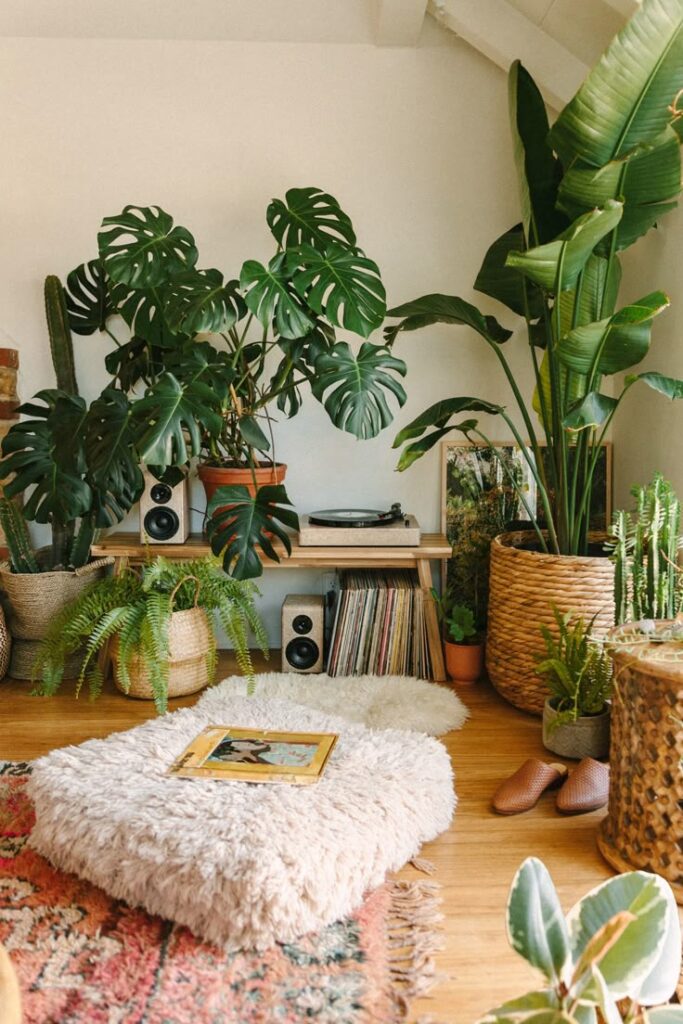
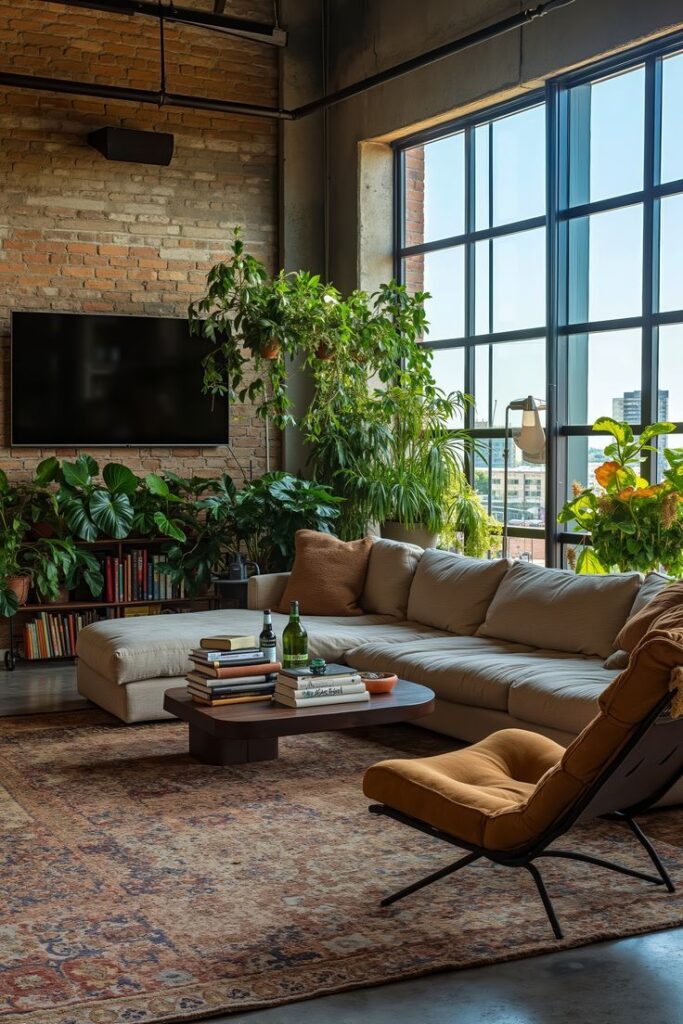
Understanding Urban Jungle Interior Design
Urban jungle interior design brings the outdoors inside, creating a lush oasis within urban environments through strategic use of plants, natural materials, and earthy elements. This design style has gained popularity as city dwellers seek to reconnect with nature despite limited outdoor access.
Defining Urban Jungle Style
Urban jungle style combines abundant greenery with contemporary design elements to create living spaces that feel like personal sanctuaries. Unlike traditional interior approaches, this style prioritizes plants as the main decorative feature rather than as mere accessories. You’ll find large leafy plants, cascading vines, and hanging planters throughout urban jungle interiors.
The style emerged as a response to increasing urbanization, allowing people to experience nature’s benefits within concrete surroundings. It differs from tropical or bohemian styles by maintaining a clean, modern aesthetic while incorporating lush vegetation.
Key identifiers include multiple plant varieties at different heights, natural textures, and a balanced color palette that allows the greenery to take center stage.
Core Principles and Aesthetic
The foundation of urban jungle design rests on several essential principles:
- Plant Diversity: Incorporating various plant species with different shapes, sizes, and textures
- Layering: Arranging plants at multiple heights and depths to create visual interest
- Natural Materials: Using wood, rattan, jute, and other organic elements for furniture and décor
Color schemes typically remain neutral—whites, beiges, and earthy tones—allowing the vibrant greens of plants to stand out. This creates a harmonious backdrop that enhances rather than competes with the foliage.
Lighting plays a crucial role in urban jungle interiors, with abundant natural light being ideal for both plant health and the overall atmosphere. You’ll want to arrange your space to maximize sunlight while providing appropriate conditions for each plant type.
Benefits of Urban Jungle Interiors
Incorporating urban jungle design into your home offers numerous advantages beyond mere aesthetics. Studies show that indoor plants significantly reduce stress levels and improve air quality by filtering toxins and increasing oxygen.
The presence of greenery has been linked to enhanced mood, creativity, and productivity. NASA research specifically highlights plants like snake plants and peace lilies for their air-purifying capabilities.
From a design perspective, urban jungle interiors create dynamic living spaces that evolve naturally as plants grow and change with the seasons. This brings a unique liveliness to your home that static décor elements cannot match.
The style also offers flexibility, allowing you to start small with a few key plants and gradually expand your indoor garden as your confidence and knowledge grow. Urban jungle design works well in spaces of any size, from compact apartments to spacious homes.
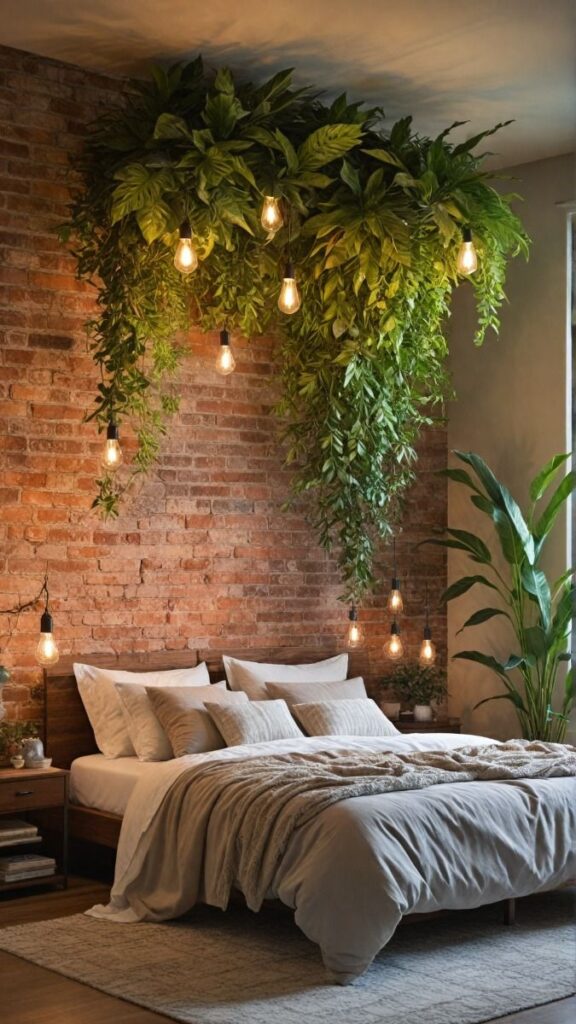

Key Elements and Materials
Creating an urban jungle interior relies on specific elements that blend natural components with contemporary design. These foundational aspects work together to transform your space into a verdant retreat that feels both wild and purposeful.
Natural Materials and Textures
Wood serves as the backbone of urban jungle design, providing warmth and organic structure to your space. Opt for furniture with exposed wood grain or raw edges to emphasize nature’s imperfect beauty.
Rattan and wicker pieces add lightweight visual interest while maintaining the natural aesthetic. These materials work particularly well for chairs, pendant lights, and decorative baskets to hold your plants.
Bamboo offers sustainability alongside style, appearing in everything from flooring to furniture accents. Its rapid growth makes it an eco-friendly choice that aligns with the urban jungle philosophy.
Don’t overlook natural fibers like jute for rugs and macramé plant hangers. These elements add tactile dimension and reinforce the organic feel throughout your space.
Earthy Tones and Bright Colors
Base your color palette on earthy neutrals like terracotta, sand, and olive green to create a grounding foundation. These hues mimic natural environments and provide visual calm amid the plant abundance.
Accent with pops of bright tropical colors—think vibrant yellows, coral pinks, and turquoise—to evoke exotic locales. Use these bolder colors sparingly in cushions, artwork, or ceramic planters.
Leaf-patterned textiles incorporate botanical themes beyond actual plants. A strategic palm-print pillow or monstera-leaf throw blanket can reinforce your jungle aesthetic.
Consider paint colors carefully—warm whites and soft greens create an ideal backdrop for plants without competing for attention.
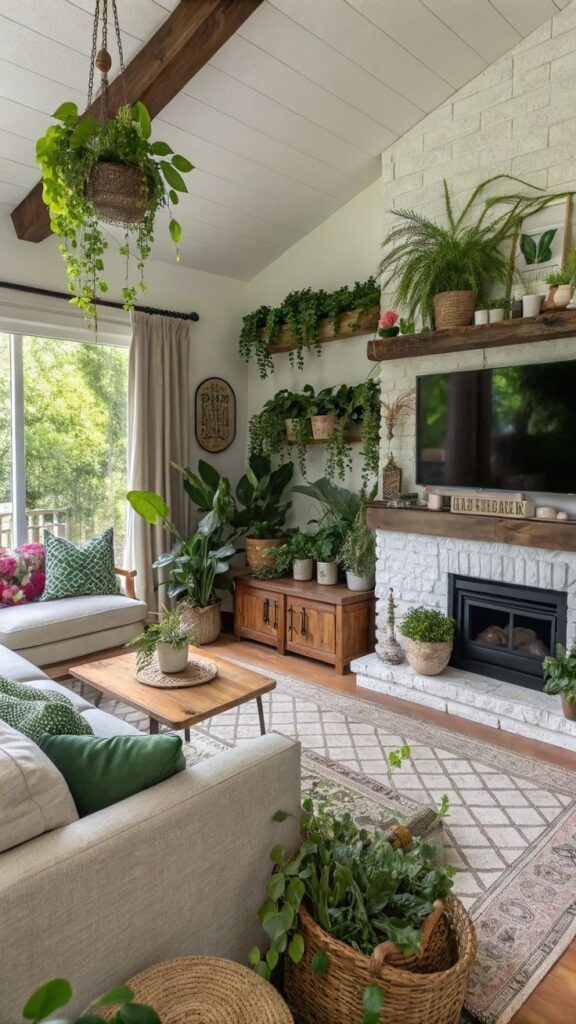
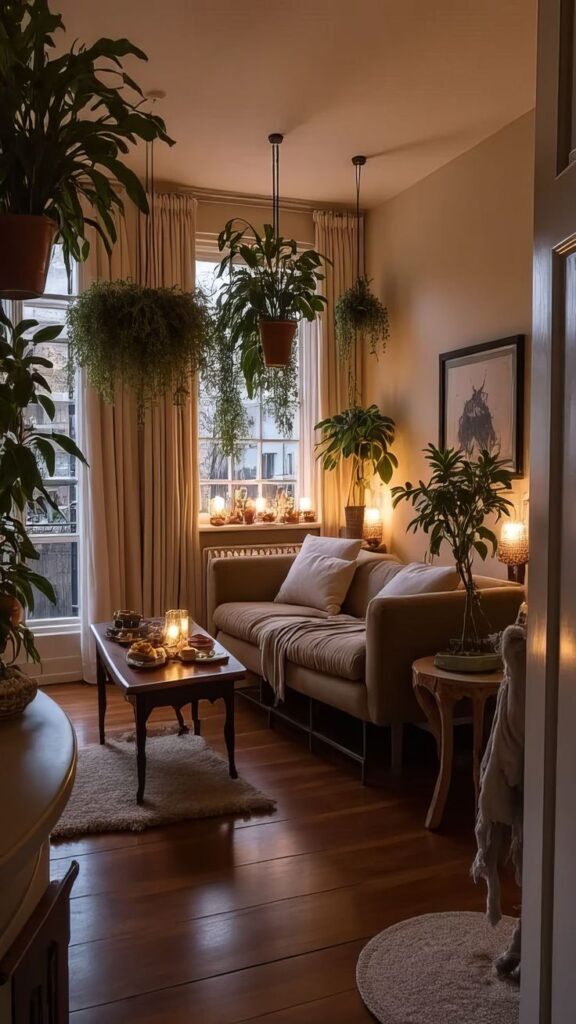
Layered Look and Textures
Vary plant heights and types to create visual rhythm throughout your space. Tall floor plants, hanging varieties, and tabletop specimens work together to fill vertical space naturally.
Mix textural elements like rough-hewn wooden tables, smooth ceramic pots, and woven baskets. This tactile diversity mimics the complexity found in natural ecosystems.
Incorporate unglazed terracotta pots alongside sleek contemporary planters for balanced contrast. The porous quality of terracotta benefits many plants while adding earthy authenticity.
Layer rugs of different natural materials to define zones within larger spaces. A jute base rug topped with a smaller wool piece adds depth and comfort.
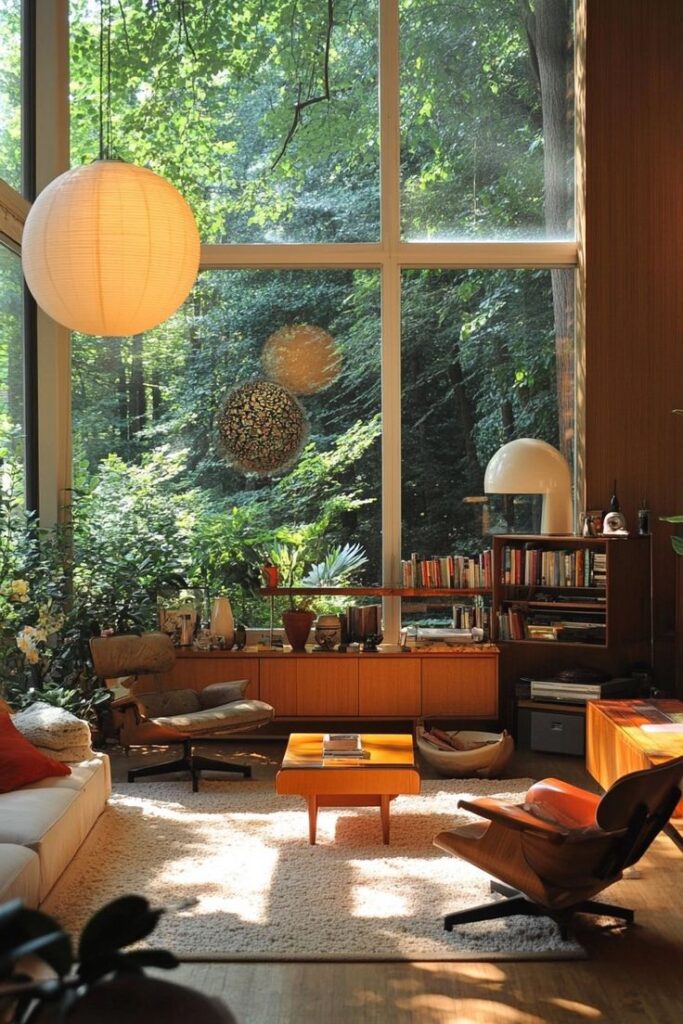
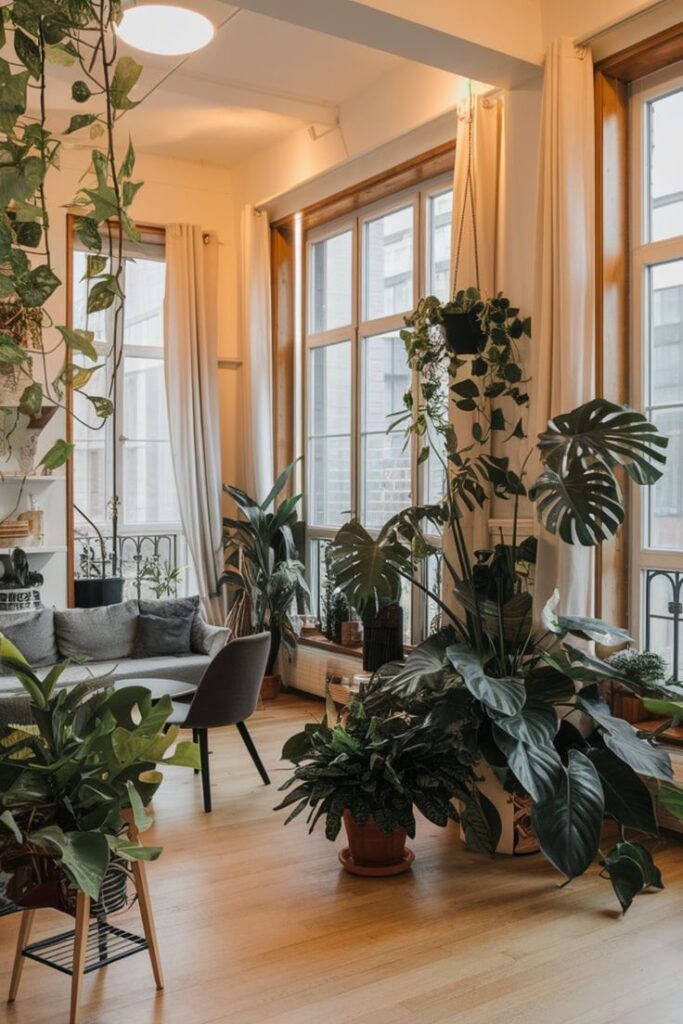
Incorporating Plants into Your Urban Jungle
Plants are the heart of any urban jungle interior, transforming ordinary spaces into vibrant, living environments. The right selection and arrangement of greenery can dramatically improve both the aesthetic appeal and air quality of your home.
Choosing the Best Indoor Plants
Start your urban jungle with plants that match your space’s light conditions and your care capabilities. For bright areas, consider a statement Monstera Deliciosa with its iconic split leaves or a tall Ficus Tree that adds height to your room. In medium light, Pothos varieties thrive—particularly Golden Pothos, which cascades beautifully from shelves or hanging planters.
For low-light corners, Snake Plants and ZZ Plants survive with minimal sunlight. These hardy options also purify air effectively. If your space receives inconsistent light, Spider Plants adapt well and produce baby plantlets you can propagate.
Consider your room’s humidity levels too. Peace Lilies and Ferns flourish in bathrooms where moisture is abundant, while Cacti and Air Plants prefer drier environments like living rooms or bedrooms.
Styling With Lush Greenery
Create visual interest by varying plant heights, textures, and leaf shapes. Place tall plants like Ficus or Palm varieties in floor planters to anchor corners, while smaller plants work well on coffee tables or shelves.
Group plants in odd numbers (3, 5, 7) for a more natural, balanced look. Try this arrangement:
- Back row: Taller plants with dramatic foliage
- Middle row: Medium-sized plants with interesting textures
- Front row: Trailing plants like String of Pearls or Pothos
Choose planters that complement your interior style. Terracotta pots offer a classic, earthy feel while ceramic planters in bold colors add personality. Woven baskets bring texture and warmth to minimalist spaces.
Macramé hangers work wonderfully for trailing plants, utilizing vertical space and adding bohemian charm to your urban jungle.
Low-Maintenance Plant Options
For busy lifestyles, focus on resilient plants that forgive occasional neglect. Snake Plants and ZZ Plants require watering just once every 2-3 weeks and tolerate most light conditions.
Pothos varieties are incredibly forgiving—they’ll show drooping leaves when thirsty but recover quickly after watering. Air Plants need only weekly misting and bright indirect light, making them perfect for small spaces or beginners.
Succulents and Cacti store water in their leaves or stems, requiring minimal attention. Place them in well-draining soil and sunny spots, watering only when the soil is completely dry.
Consider these care requirements when selecting plants:
| Plant Type | Water Needs | Light Requirements | Difficulty Level |
|---|---|---|---|
| Snake Plant | Low (2-3 weeks) | Low to Bright Indirect | Very Easy |
| Pothos | Medium (7-10 days) | Low to Medium | Easy |
| ZZ Plant | Low (2-3 weeks) | Low to Medium | Very Easy |
| Air Plants | Low (weekly mist) | Bright Indirect | Easy |
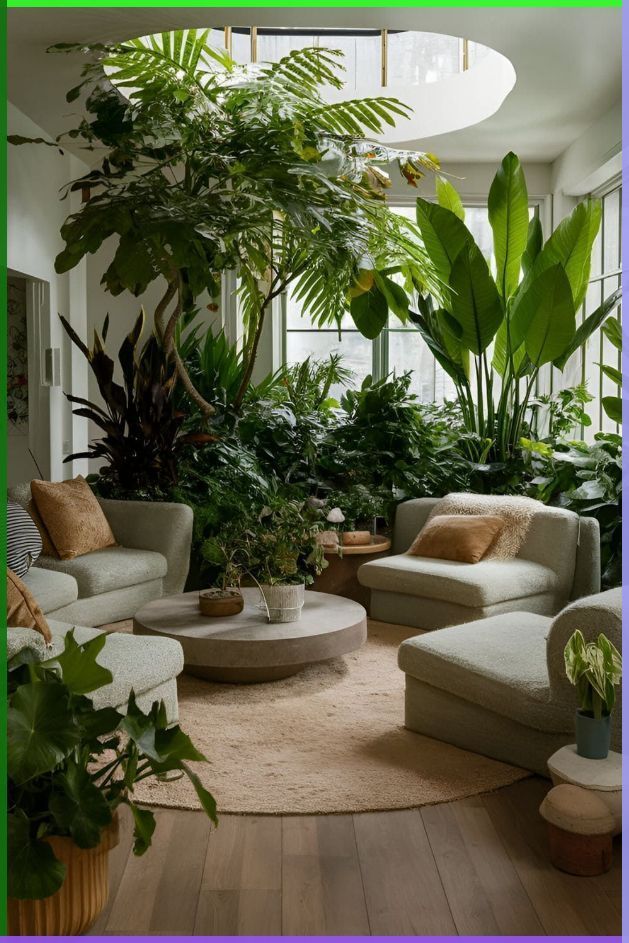
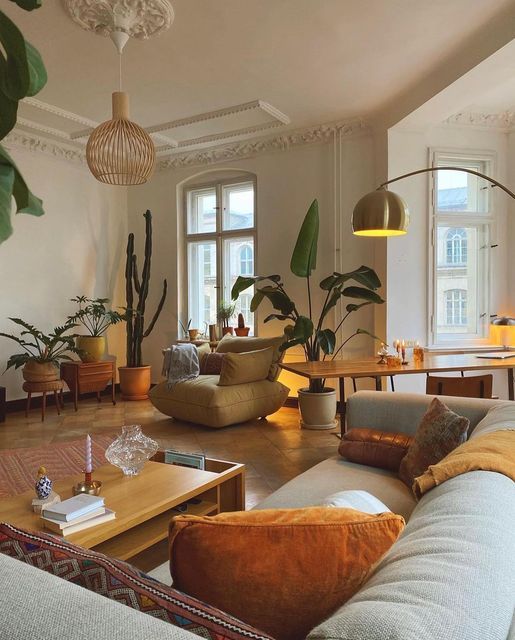
Design Techniques for Urban Jungle Spaces
Creating an urban jungle interior requires strategic placement of plants and thoughtful design elements that enhance their presence. The following techniques will help you transform any space into a lush indoor oasis that balances aesthetics with functionality.
Green Walls and Wall Planters
Green walls serve as stunning focal points in urban jungle interiors, transforming plain surfaces into living art. You can install a professional living wall system with built-in irrigation or create a more affordable DIY version using modular wall planters.
Wall-mounted plant holders work exceptionally well for displaying trailing plants like pothos or philodendron. For a structured look, arrange succulent wall art in geometric patterns, creating a low-maintenance yet visually striking installation.
Consider vertical garden pockets made of fabric or plastic for herbs and small plants. These systems maximize vertical space while adding texture to your walls. When planning your green wall, ensure your wall can support the weight and install proper waterproofing to prevent moisture damage.
Hanging Plants and Ceiling Baskets
Hanging plants add dimension to your urban jungle by drawing the eye upward and utilizing often-neglected ceiling space. Macramé plant hangers offer a bohemian touch that complements the natural aesthetic of an urban jungle living room.
Install ceiling hooks or hanging rails to suspend plants at varying heights, creating visual interest and depth. Spider plants, string of pearls, and Boston ferns thrive in hanging baskets and produce dramatic cascading effects.
For a modern approach, try glass terrariums or metallic hanging planters. These can be clustered in corners or arranged in a row to define areas within open-plan spaces. Always ensure your ceiling fixtures can support the weight, especially when plants are freshly watered.
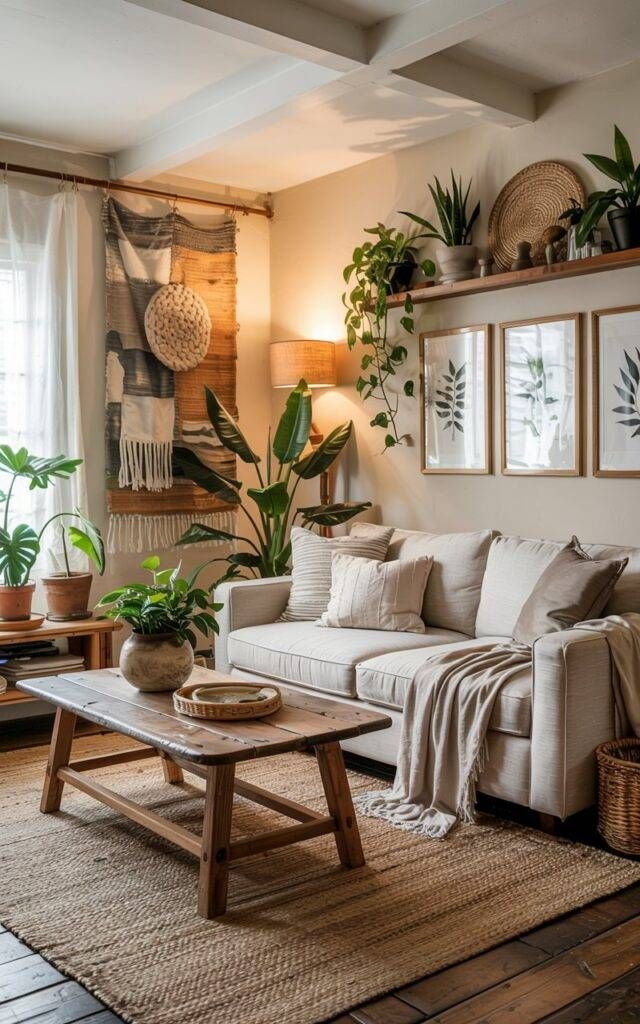
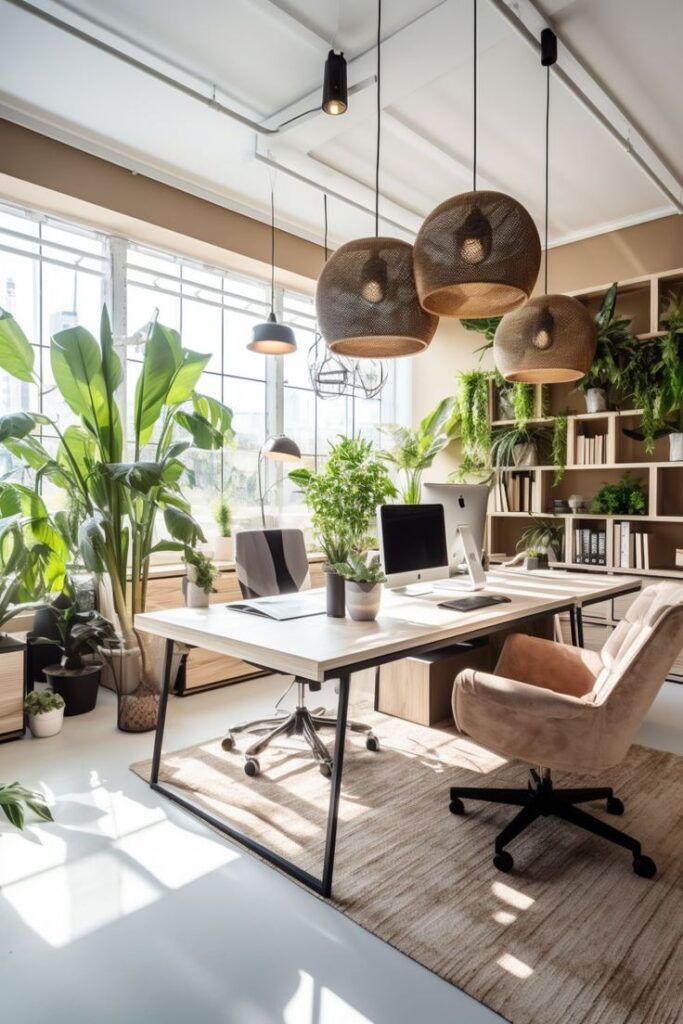
Maximizing Natural Light
Plants need adequate light to thrive, making light optimization crucial for your urban jungle. Position light-loving plants near windows while reserving low-light varieties like snake plants and ZZ plants for darker corners.
Consider installing sheer curtains rather than heavy drapes to diffuse bright direct sunlight without blocking it completely. This creates ideal conditions for most tropical houseplants. Clean your windows regularly to maximize light penetration.
Rotating plants quarterly ensures even growth and prevents them from permanently leaning toward light sources. For spaces with limited natural light, full-spectrum grow lights can supplement available sunlight, extending your plant palette options considerably.
Mirrors and Moody Lighting
Strategically placed mirrors amplify natural light by reflecting it deeper into your space, benefiting plants in shadowy areas. Position mirrors opposite windows to double the perceived light and create the illusion of more greenery through reflections.
For evening ambiance, layer lighting with a combination of overhead fixtures, floor lamps, and string lights woven through plants. Warm-toned bulbs (2700-3000K) enhance the rich greens of your plants and create a cozy atmosphere.
Consider installing dimmer switches to adjust lighting levels throughout the day. Highlight statement plants with directional spotlights or uplighting for dramatic shadows that enhance the jungle feel. Small LED strip lights can illuminate shelving units or green walls, showcasing your plant collection even after sunset.
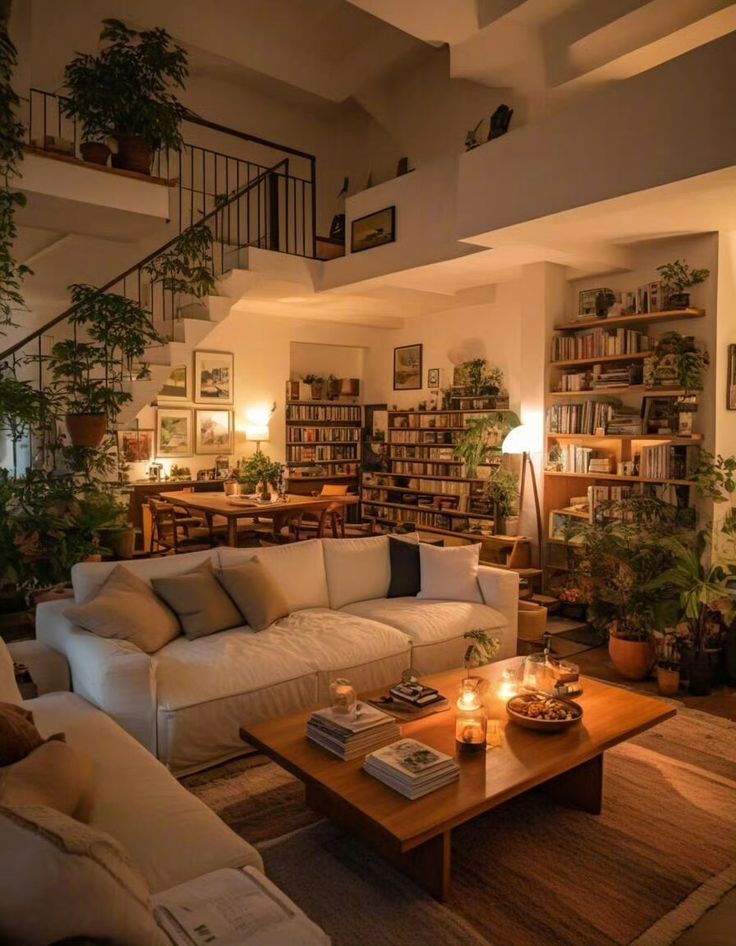
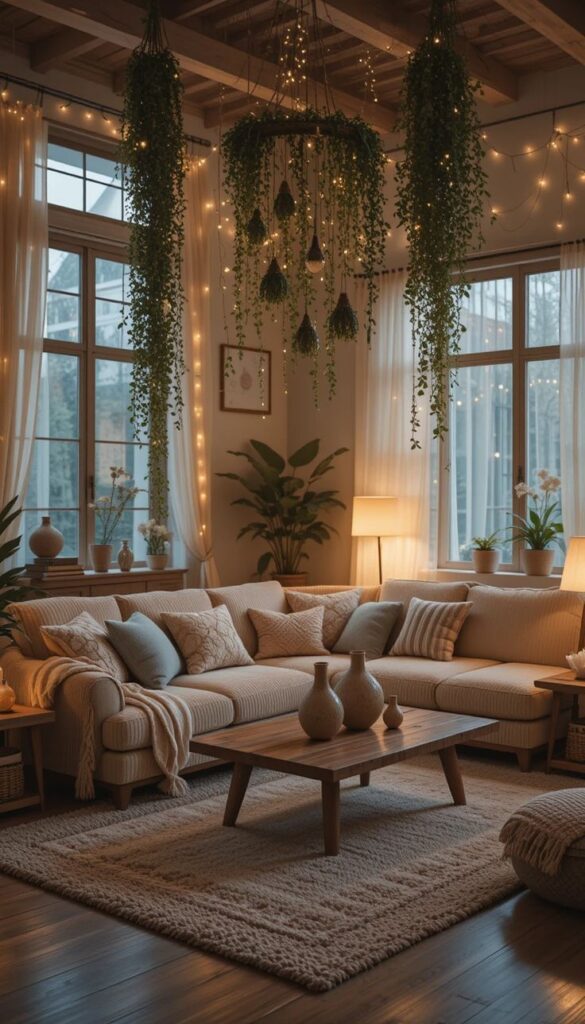
Decor, Accessories, and Finishing Touches
The right decorative elements transform an ordinary space into a lush urban jungle retreat. These finishing touches create depth, texture, and visual interest while reinforcing the natural theme throughout your home.
Furniture and Accessories
Select furniture that complements your plants rather than competing with them. Natural materials like wood, bamboo, and stone create an authentic foundation for your urban jungle aesthetic.
Opt for mid-century modern pieces with clean lines and tapered legs to balance the organic shapes of your plants. A wooden coffee table or sideboard provides warmth and grounds the space.
Add textiles in earthy tones like forest greens, terracotta, and natural browns. Layer rugs with subtle patterns or jute textures to create visual interest without overwhelming the greenery.
Incorporate cushions and throws with subtle leaf patterns or natural textures. These soft elements make your space feel cozy while reinforcing the jungle theme.
Rattan and Wicker Furniture
Rattan and wicker pieces are essential elements in urban jungle design, bringing texture and a tropical feel to your space. These materials create a relaxed, bohemian vibe that perfectly complements abundant greenery.
Consider a rattan hanging chair or peacock chair as a statement piece. These iconic designs create an instant focal point and provide the perfect spot to enjoy your plant-filled sanctuary.
Wicker baskets make practical plant holders while adding texture. Use them as decorative covers for plastic nursery pots or as storage for smaller plants and gardening supplies.
For dining areas, rattan chairs paired with a wooden table create an inviting, natural atmosphere. The contrast between materials adds visual interest without feeling cluttered or overwhelming.
Botanical Prints and Wallpapers
Botanical artwork and wallpapers amplify the urban jungle aesthetic when used thoughtfully. Large-scale leaf prints or vintage botanical illustrations create focal points that complement your live plants.
Choose wallpaper with monstera leaves, palm fronds, or ferns for an accent wall. This creates depth and reinforces the jungle theme without overwhelming the space. Bold patterns work well in smaller areas like entryways or bathroom walls.
Frame vintage botanical illustrations or modern leaf prints in simple frames with natural finishes. Group these in galleries for maximum impact or use larger pieces as statement art.
Mix in photographs of tropical landscapes or close-up plant details for variety. Black and white botanical images offer a sophisticated alternative that works well in more minimalist spaces.
Tropical and Nature-Inspired Accents
Small decorative elements bring cohesion to your urban jungle design and allow for personal expression. These accents add character while reinforcing the natural theme throughout your space.
Incorporate decorative objects like wooden sculptures, ceramic animals, or stone figures. Parrots, toucans, or other tropical bird motifs add whimsy and color to shelves or tabletops.
Use natural materials for practical items like wooden coasters, stone bookends, or cork trivets. These functional pieces contribute to the organic feel while serving everyday purposes.
Place scented candles with earthy fragrances like cedarwood, moss, or fig to engage multiple senses. Glass terrariums filled with air plants or succulents create miniature landscapes that require minimal maintenance.
Consider metallic accents in brass or copper to add warmth and reflect light. These materials contrast beautifully with greenery and add a sophisticated element to the natural aesthetic.
- 0shares
- Facebook0
- Pinterest0
- Twitter0

